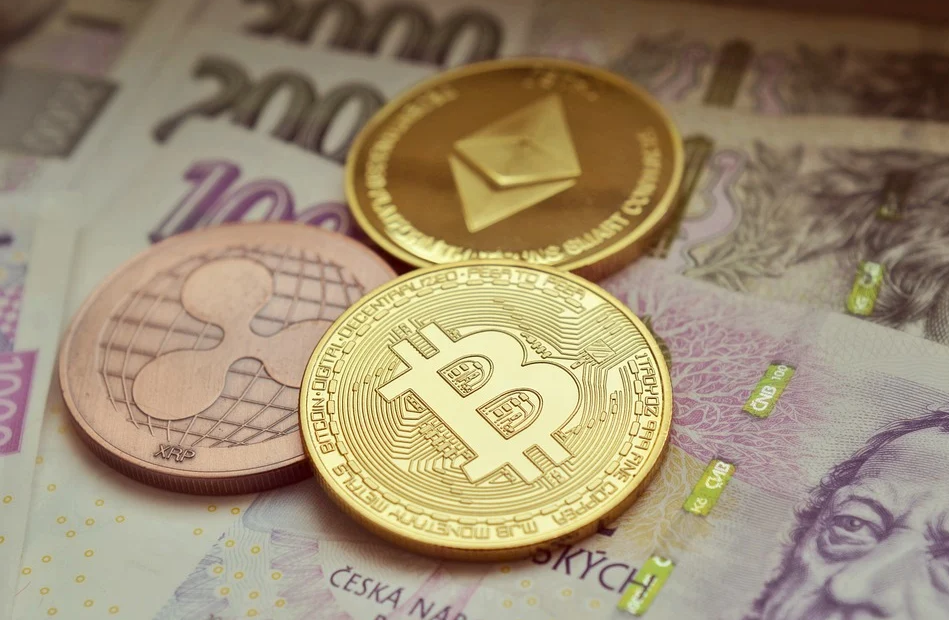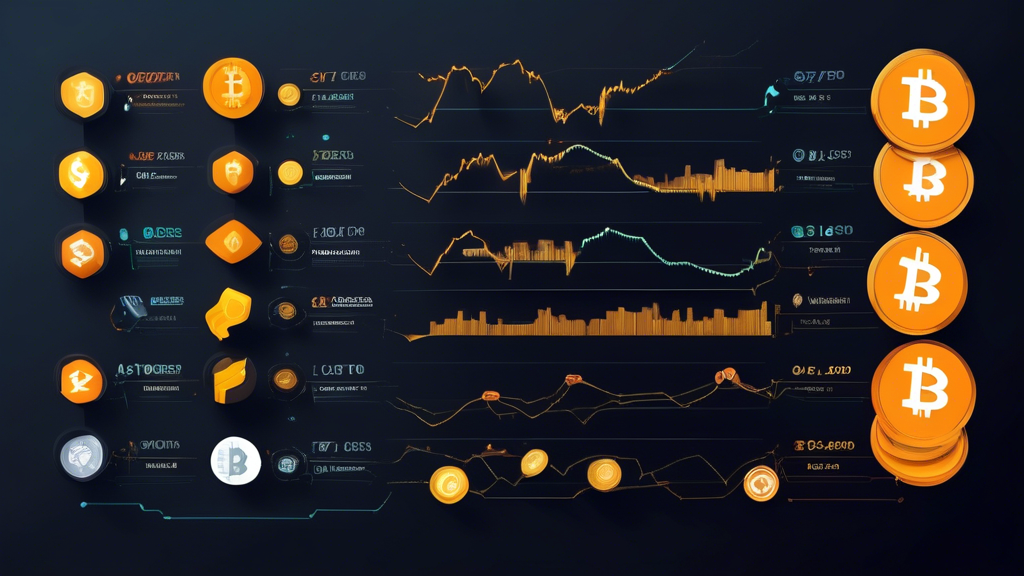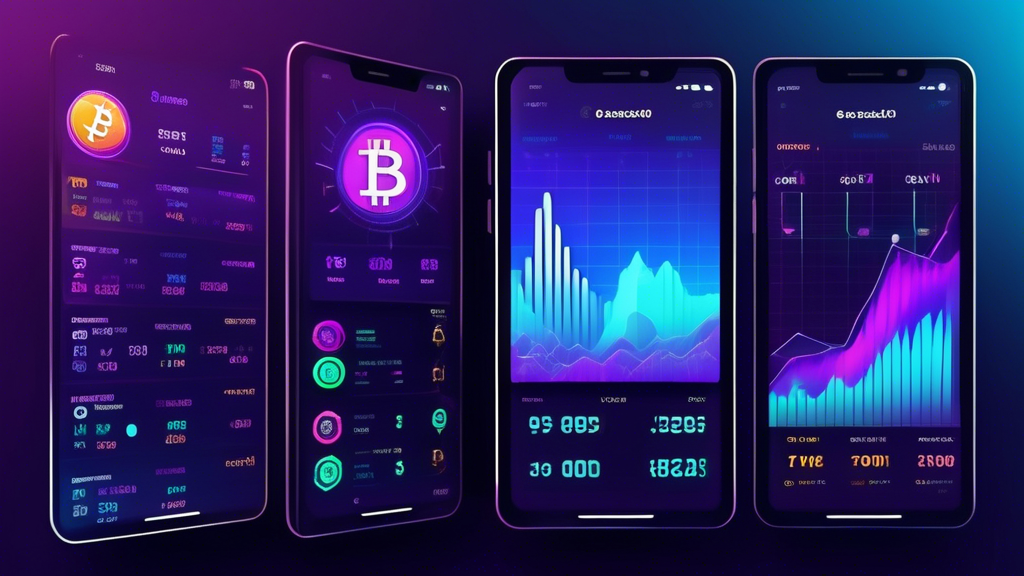Do you want to look into the future with me? See refrigerators that buy butter yourself? Machines that talk to each other like C3PO? Welcome to the world of so-called Altcoins: the alternative coins to Bitcoin. Seven exciting Altcoins I will introduce to you today. Let’s take a look into the future together!
Why does the World need Altcoins?
You scan the list of cryptocurrencies, you get the creeps: Why does the world need so many currencies (over 5,000)? And you’re right: Most of them are more unsuitable than a Trabant on the highway.
Nevertheless, cryptocurrencies have moved out to revolutionize the monetary system. And now we have the revolution: the free competition of currencies.
No central bank determines which currency you should hold. You can decide for yourself – and only according to your preferences, as if you were buying coffee.
What will it be: cappuccino or latte macchiato? The cryptocurrencies are no different: Bitcoin or Ethereum? What is in demand will prevail – what people want. That is free competition.
That’s why there are so many coins, because everyone is fighting for a place on the podium. But let’s be honest: Of the hundreds of coins, most are scrap and won’t survive.
But that’s what competition is for: The trash flies out and the good stuff stays. “Good things go in the potty, bad things go in the crock,” like Cinderella’s pigeons cooing. But that’s not the only reason:
Many Altcoins seem like a science fiction film: machines talk to each other (Iota) or houses rent themselves out (Ethereum). They can change our world forever.
That’s why they are so important, because they are a glimpse into the future: What will be possible? What will our world look like? What is the financial system of tomorrow?
“He who is late will be punished by life.” As Gorbachev said when he tore down a stone block chain.
You want to miss the future? I don’t think so. Late comers are always tomorrow’s poor. But don’t panic: I’m not saying that individual Altcoins will definitely prevail.
I’m just saying: cryptocurrencies are indispensable and can change the world in the coming decades, just like the Internet once did.
So let’s take a look at the future now. What is already possible today? What could soon be possible?
For this purpose, we look at seven promising old coins – but they are not recommended to buy!
How you choose profitable Altcoins to buy is explained in the last section.
Ethereum
Ethereum is the crowned number 2 behind Bitcoin. But what does this Coin do? First of all: Ethereum is a network; the coin behind it is called ether. And that’s what Ethereum wants:
Think of Ethereum as a second Internet – with only one difference: The data is stored decentrally. What does that mean?
There are no large servers like Google, where your photos or videos are stored in the cloud. Decentralized data is stored via the block chain on all devices that participate in the Ethereum network.
The data is publicly accessible and therefore forgery-proof – anyone can check if this and that happened.
Of course: Bitcoin is based on this, too. But what is so special about Ethereum? Because it is like a second Internet, countless programs can be installed on it.
Think of it as a website:
The Blockchain is suddenly running a delivery service. All you have to do is send it a certain amount of ether, and it will ring your doorbell and bring you the pizza.
Of course, Ethereum can deliver much more than pizza. So let’s look at the two most powerful functions.
Smart Contracts
Smart means smart, contracts means contracts – so smart contracts are smart or clever contracts. That means: They are contracts that execute themselves.
How else does a contract work? Two or more people meet, discuss, vote and finally draw up a contract – they agree on something. There is only one problem:
They have to trust each other. If one partner does not comply with the contract – for example, he does not deliver the goods – then the contract is void. His partners are the bounced ones.
Smart Contracts circumvent the problem: There is no trust, only programmed procedures. The contract is executed automatically.
If I send my partner the money, the contract is automatically activated. The supplier is notified (the money is that) and sends me the goods.
This principle could turn our whole financial system around like a falling jam bread. Let’s just take the house purchase: with Smart Contracts we no longer need notaries.
You simply transfer the necessary sum to an office; you are automatically registered in the land register – without any middleman.
This would be like “The biggest loser” for the bloated bureaucracy – the authority pounds would fall.
Decentralized applications (d’Apps)
D’Apps are programs that do not run on a server – they run locally throughout the network. This makes them forgery-proof but above all censorship-proof.
Take a Wikipedia d’App for secret information as an example. With this program, all Ethereum users could access all CIA data, for example – and no one could censor or delete it.
Of course, this is slightly scary; but there are also normal games as d’Apps. Imagine Angry Birds, which you don’t download from the App Store, but play on the Blockchain.
The application possibilities are enormous – and even today it is impossible to estimate them. How about a decentralized Airbnb with Smart Contracts?
You transfer the rent due and as if by magic the smart lock of the house opens for you. With d’Apps you can automate everything that does not require human intervention.
The currency for the d’Apps and the whole network is then ether. Nevertheless, other currencies can also run on the Ethereum block chain – they are called tokens.
Tokens are cryptocurrencies without their own block chain. They can also be used as a means of payment for d’Apps, for example. Like the Airbnb example above:
To rent an apartment, you simply use the Airbnb token – a currency within the particular d’App.
The advantages of Ethereum:
- Finances, contracts, authorities… everything can be automated through Smart Contracts.
- There are d’Apps that run on the Ethereum block chain.
- These programs can change the world – from entertainment to the financial industry (DeFi).
Even rich people have their little problems – especially when they want to transfer money. Have you ever transferred 10 billion euros? Only then do you see how hard life really is.
Because the fees are enormous; and a classic SEPA transfer allows a maximum of 999 million euros. In addition, the house bank must first find a bank abroad to accept the money (correspondent bank).
The Altcoin Ripple solves these problems like a digital MacGyver. This is because Ripple is a payment protocol that makes foreign transfers of large sums of money possible. This is how it works:
Ripple is a digital database that keeps track of all account entries and withdrawals. This is why transfers are transparent and forgery-proof. But how do transfers work?
They run on the consensus principle: All members agree that account A (I transfer) and account B (I receive) change. This change in the payment book sounds complex, but the transaction speed is only a few seconds.
This is because Ripple is a largely centralized system – the company behind Ripple holds all Validator Nodes. It is these Validator Nodes that confirm the transaction, i.e. carry out the transfer in XRP (“Ripples”).
This is because transfers are mainly made via XRP. But this Altcoin fluctuates in value? Yes, but it is still unimportant, because the transfer only takes seconds.
Nevertheless, other currencies can also run on the Ripple protocol – XRP is only the “first mover”; it is not mandatory.
So banks could make themselves independent of XRP by having developers create their own Altcoins for them. Via them they then transfer money in the system.
The advantages of Rippe: Secure and cheap transfers across national borders, where billions of dollars between banks are no problem.
Tether
Not all Altcoins jump back and forth in value like a pebble in a mixer. There are also coins that keep their value. They are Stablecoins – “stable coins”.
They are firmly bound to a currency and fall or rise with it. The most prominent Stablecoin is Tether. It is available in the dollar version (USDT) and as Euro (EURT). But what is it good for?
Very simple: Tether is the dollar or euro substitute on the block chain. So you don’t laboriously send the hard currencies back and forth, but tether – this is faster and cheaper via the block chain.
If necessary, you simply exchange tether back into dollars or euros without losing value (except the fee). For example, you can quickly send “dollars” to a stock exchange to buy Bitcoin.
Nevertheless, Tether is not an untouched nun who prays her rosary piously every day. This Altcoin is often criticized:
No one knows if Tether holds enough dollars or euros. After all, you have to hoard a lot of money to tie the crypto currency to it. Because USDT must also be sufficiently covered with USD.
Otherwise, tether turns out to be an empty number, because there is no real value behind the stable coin.
Of course Tether assures that there are enough reserves – only an official confirmation is missing. The crypto-community doesn’t mind though:
Tether’s as popular as a stripper at a bachelor party. Previous accusations could not shake this. The Altcoin Tether enjoys enough trust in the meantime.
The advantages of Tether:
- Secure and fast transfers
- Smooth exchange into fiat money (Dollar, Euro)
- Low fees
- Tradable on all major platforms
Cardano (ADA)
Cardano is the problem solver among the Altcoins. Wherever there is a fire, Cardano wants to intervene and extinguish the fire – i.e. correct the fault.
That’s why Cardano is quite slippery and difficult to grasp, because his purpose is to make everything better that Bitcoin and the Altcoins failed to do.
In doing so, we are no longer dealing with hip programmers who barricade themselves in their homes and change the world. It will be academic:
Academics, researchers and crypto-generals (e.g. an Ethereum founder) are working on the Cardano Network. And only according to academic standards, to avoid possible mistakes.
Even if Cardano is intangible for laymen (like me) like soap in a bathtub, these are the projects and goals for the future:
- To further develop and spread the ADA’s own currency
- Expansion and improvement of Smart Contracts and d’Apps (like Ethereum)
- Make payment transactions easy and secure for individuals, banks and central banks
- Be usable for large institutions (no loss of money in billion-dollar transactions)
Secure, fast and arbitrarily large transfers even between individuals.
Prevention of ADA being used for money laundering and illegal activities (establishing trust with large institutions).
Cardano can therefore be summarised as follows: better than the other Altcoins. Whether the project will prevail and Cardano has potential, the future will show.
Litecoin (LTC)
Bitcoin would be a model candidate for the drug advertisements on ARD and ZDF. Bladder weakness? Knee problems? You don’t fall asleep at night?
Then they take Litecoin: Because Litecoin tries to fix the problems of Bitcoin. These problems are:
Transfers with Bitcoin take too long: For one thing, a new block is created only every ten minutes; for another, not many transactions fit into the block. What do I mean by that?
The miners convert transactions into hashes – cryptographic codes that guarantee security. These hashes fit into the block.
The problem: at some point the block is full; more transactions have to wait.
This arouses the greed of the miners: they prefer to include these transactions in the block, which pay higher transaction fees. Sure: They also want to earn something.
That is why it is unprofitable to send small amounts of money with Bitcoin.
Litecoin now circumvents this problem in two ways: The blocks are larger and the processing is faster (a new block is created every two minutes and thirty seconds).
This allows Litecoin to transfer more money peer-to-peer than Bitcoin in the same time period. Furthermore, transfers are much cheaper.
Advantages of Litecoin: transactions with Litecoins are faster and cheaper than with Bitcoin.
Monero (XMR)
4,645.302147 XMR – that’s how much it would cost to order a live gorilla in darknet Because in Darknet XMR flows like beer at the Oktoberfest – very abundantly. But why?
It turns out: Bitcoin isn’t as anonymous as people think. With the right technique and the right effort, transactions can be tracked down – much to the chagrin of the advocates of criminal tendencies.
That’s why Monero has risen – rather involuntarily – to an excellent substitute; because it is 100 percent anonymous. There are three reasons for this:
Group transactions: Transactions can be grouped together; in this way the individual user only appears as a member of the group and cannot be tracked individually. The transaction is attributed to the whole group.
RingCT: This function conceals the amount of the transaction. Why? Multiple large transactions are suspicious and arouse curiosity.
Unpublishable block chain: Unlike Bitcoin, the block chain and thus the transaction history is not publicly viewable. Nevertheless, you can personally make your transactions visible, namely with a separate key.
Another advantage of Monero is that it is easier to mine – and without enormous power consumption. You can mine XMR with a normal computer – high-end miners like Bitcoin are not necessary.
This prevents individual miner pools from controlling the voting rights; just because large mining farms confirm most transactions.
To repeat: In Bitcoin, the miners have the say because they confirm transactions. But mines are expensive, which is why mining pools and mining farms have emerged.
Miners work together there – and as aristocrats or oligarchs they determine the block chain. No update will get through until they agree.
This makes the Monero network significantly different and thus more democratic – really anyone can become a miner.
The advantages of Monero: Amazing anonymity during the transfer and the inexpensive option of mining Altcoins using your own PC.
Bitcoin Cash
Bitcoin is known to be the gold of the block chain – a store of value that is supposed to increase in value over time. As a means of payment it is not that practical, as I have shown above with Litecon.
The Bitcoin friends were aware of this and solved the problem: They created a Bitcoin alternative that works like cash on the block chain. Just Bitcoin Cash. What is so special about it?
The blocks are eight times larger than Bitcoin (8 MB in total). That means more storage space for transactions.
As a result, more transactions are processed per second, which also lowers fees.
This makes Bitcoin Cash attractive as a means of payment. Everything else is the same as with Bitcoin:
For example, Bitcoin Cash is also limited to 21 million units.
It is also interesting how Bitcoin Cash came into being: It was a cesarean section of the block chain after the community split.
Hard Forks
Such a fork is called a hard fork. Let’s take a closer look at this; because hard forks are an important concept that makes decentralized networks so extraordinary.
Every crypto currency needs a set of rules, such as how large a block may be or how long a transaction takes. This set of rules is called protocol.
However, the protocol only applies if the miners – those who confirm transactions – accept it. Clearly, laws achieve nothing if nobody applies them.
Whether they accept the protocol is up to the miners – but they want to earn money and therefore stick to the community.
But what happens if a large part of the community is dissatisfied?
Then the members split like the Judean Popular Front and the Popular Front of Judea. This happens in the form of updates – these are changes in the protocols.
One part of the miners accepts the update, the other part does not, and the split of the block chain is complete.
It is now forked into two different block chains with different protocols. This is the hard fork.
That’s how cryptocurrencies develop apart, an alternative is created – just like Bitcoin and Bitcoin Cash.
Are Altcoins financially worthwhile?
Technology and digital breakthroughs are all well and good, but what’s in it for you – and in ringing coins?
It’s a legitimate question: Everyone wants to make a profit with their coins; their value should rise sharply. Only one question remains: What do you think of profitable coins?
That’s not so easy – or rather: impossible, because nobody can look into the future. Can you be sure, for example, that Apple will still be a leading company 20 years from now?
Exactly: Such a forecast is as uncertain as the weather next week.
Neither can you predict a currently deadly chic Altcoin’s life expectancy of 20 years. These are the disadvantages of speculation.
So caution is advised. But the question remains:
Which Altcoins should you buy?
There is no such thing as certainty; however, there are a number of criteria that can determine the value of a coin:
Market capitalization: This is the number of available coins x the price of a coin. The higher the market capitalization, the more money is in the network. That is:
More people believe in the altcoin, which makes it safer. In addition, the price doesn’t fluctuate that much. I pump a billion into a small coin, the price goes through the roof.
On the other hand, if I pump it into a big coin, the price just twitches like the EKG of a healthy person. So the higher the market capitalization, the better.
Age: Older coins (several years) have proven their functionality – the network has accepted them. That creates trust.
Function: Every good Altcoin needs a unique function – what is its extraordinary benefit? Because it is his business model that makes him stand out from the crowd.
You have to know, understand and believe in it. You have to be convinced: Yes, this is the future; this function will change the world forever.
If you don’t understand an Altcoin, don’t touch it like a hot stove. “Invest only in what you understand.”
You can always read about the function and vision of an Altcoin in the appropriate white paper.
Only the 20 biggest coins on the market: That’s not a rule, it’s a personal opinion. Observe the 20 largest coins by market capitalization. Look at them and understand them.
Then digitally create a portfolio of the most promising old coins – that’s it. Why? cryptocurrencies are speculative; and the smaller the coin, the more speculative it becomes. That is:
you can lose a lot very quickly.
Of course, you could also miss opportunities, because small Altcoins are one hundred percent more likely to jump than large ones. With Bitcoins you won’t get stinking rich overnight.
You have to decide whether it is worth investing – after all, it is your money and your responsibility.
Sure: Coins like Iota or Dash are interesting, but not in the top 20. I prefer to play it safe here – but that is just my opinion and rule of thumb.
You are welcome to discard them instead, if you have studied various Altcoins and their development in detail.
But where do you get the knowledge from?
You can find all the necessary information about Altcoins (function, developments, share price, market capitalisation…) at www.coinmarketcap.com
Do you want a simple guide on how to avoid mistakes when buying and selecting guaranteed? Then read the article under cryptomarket.



